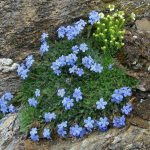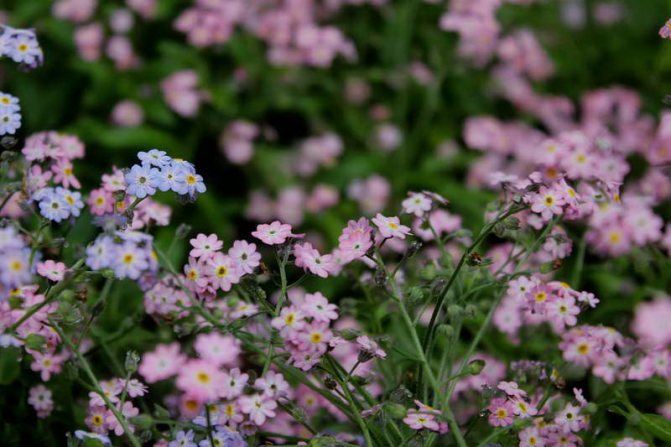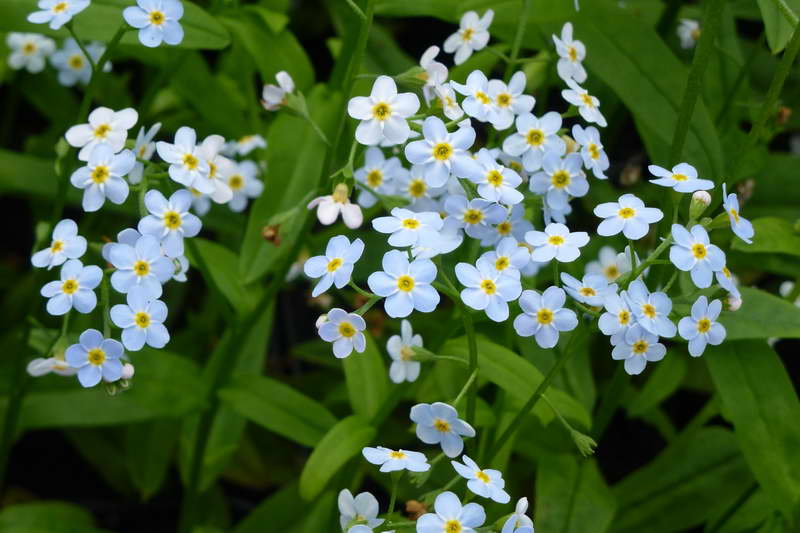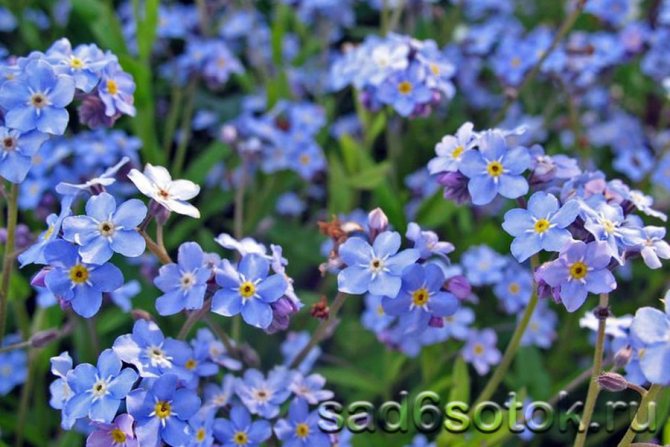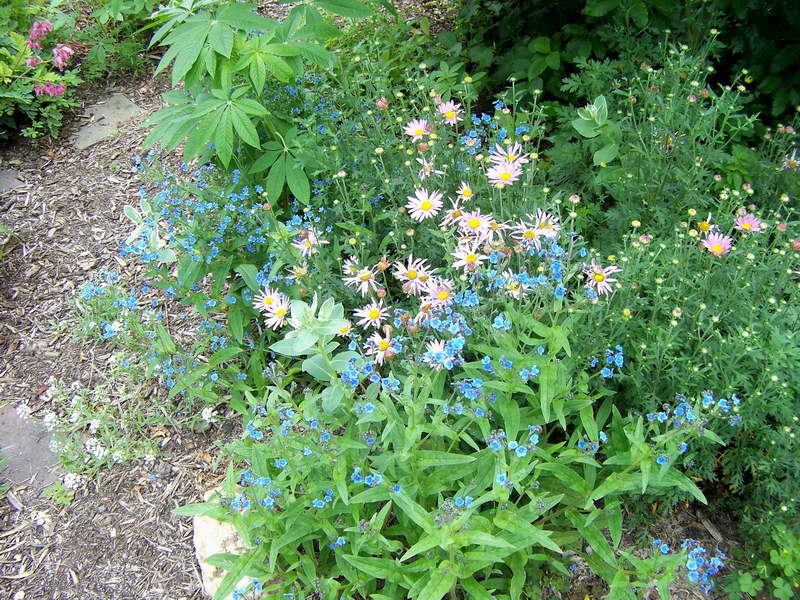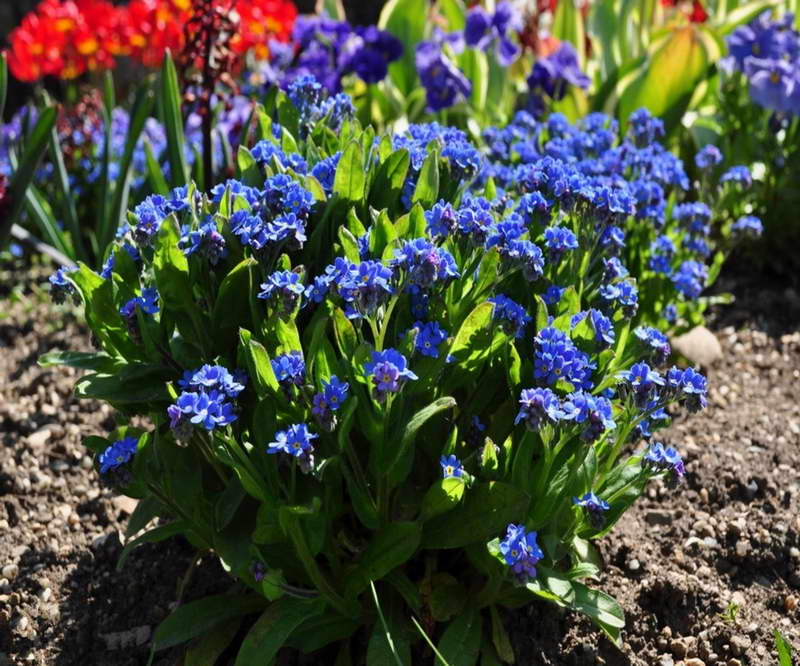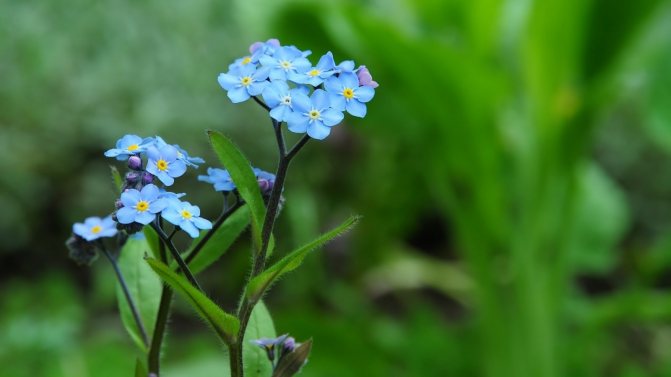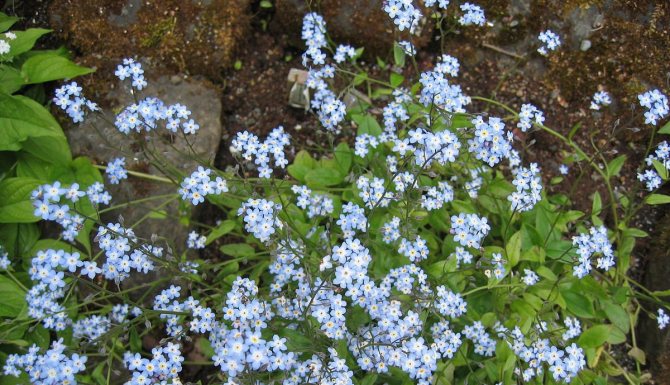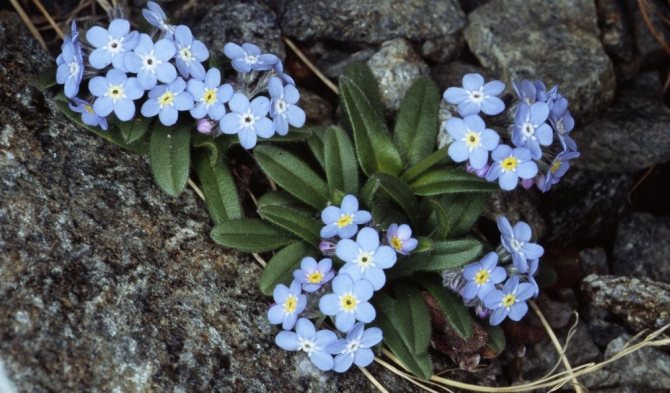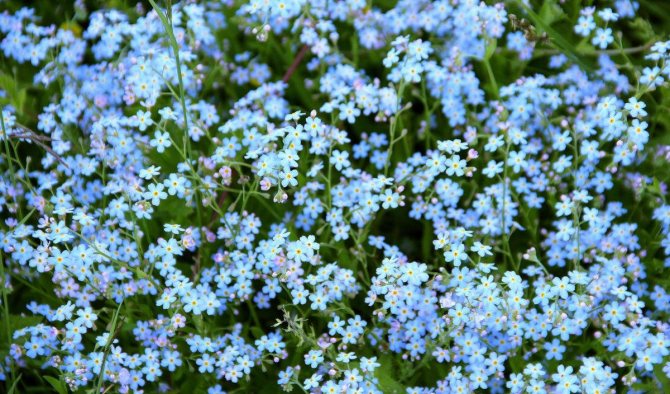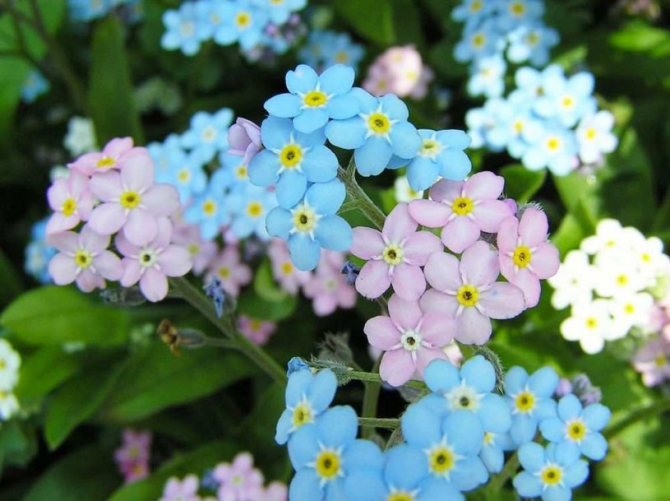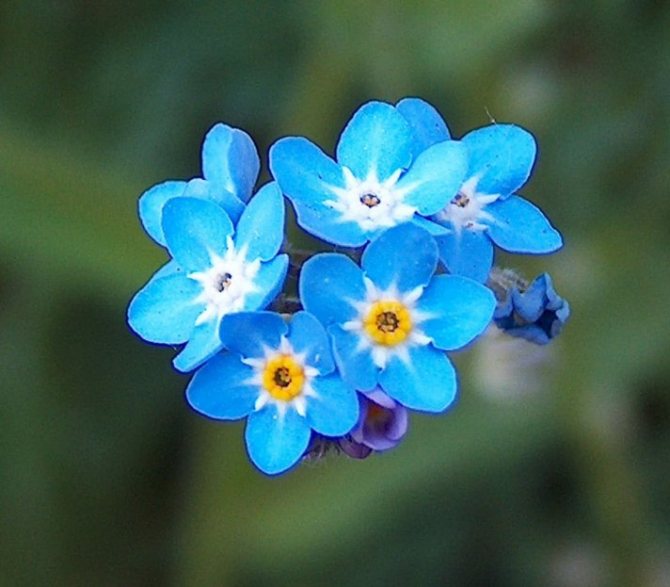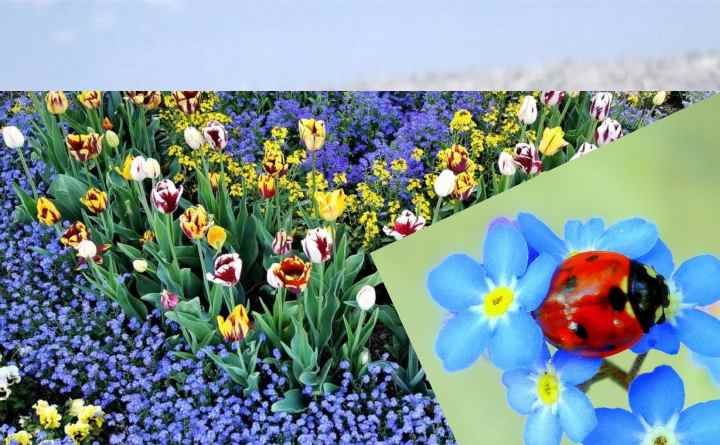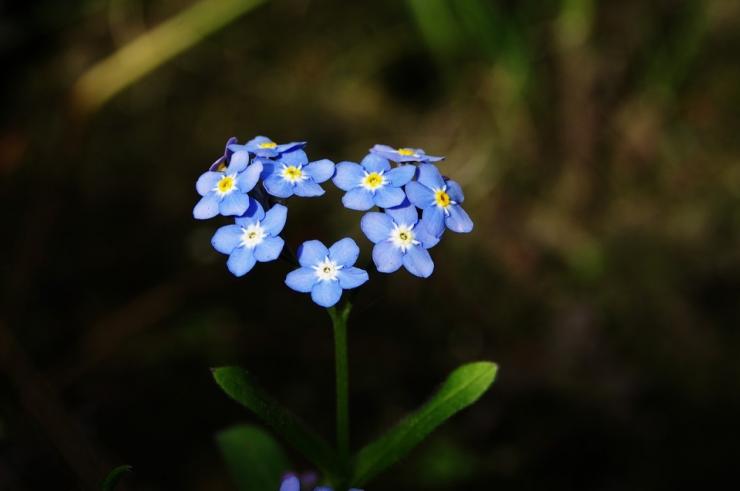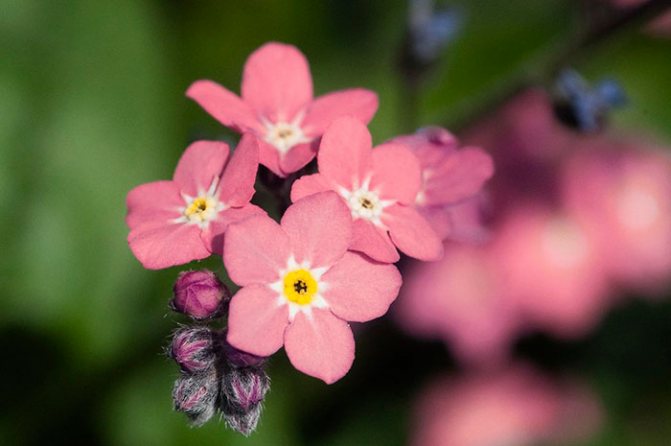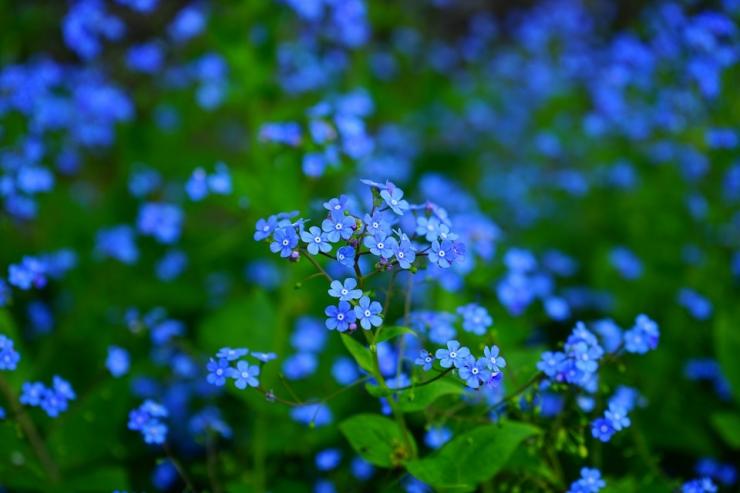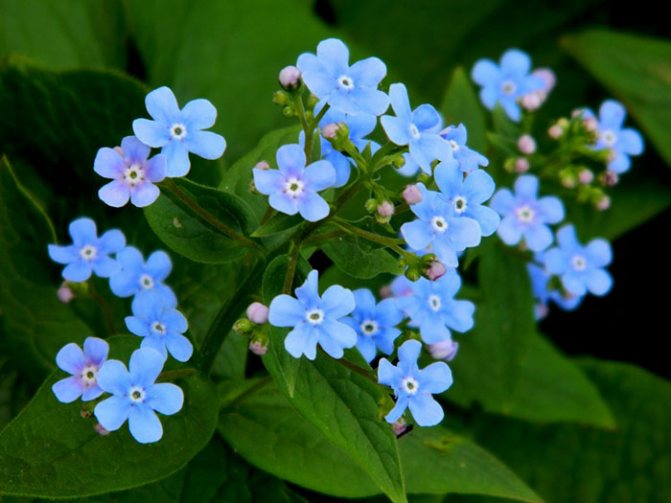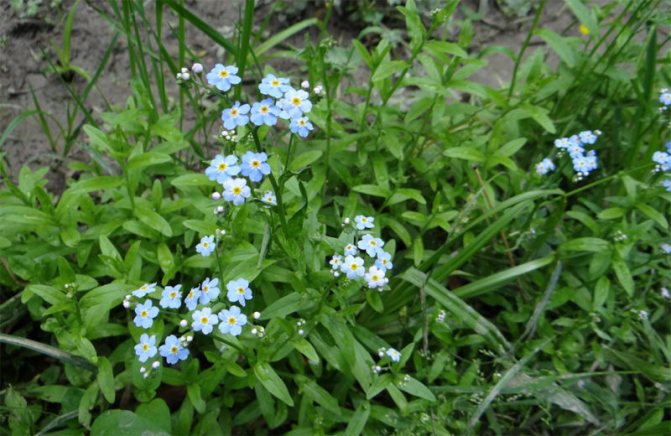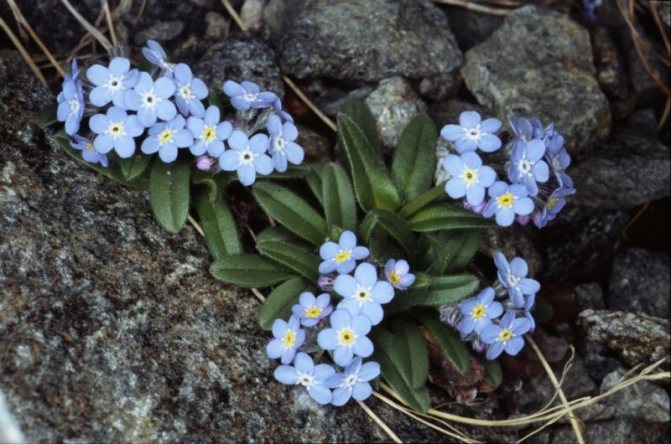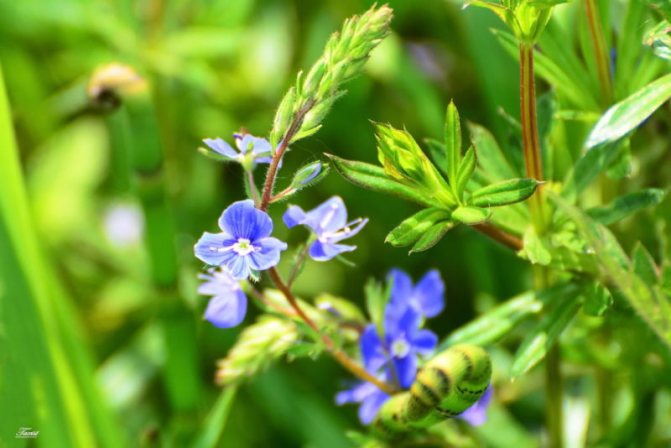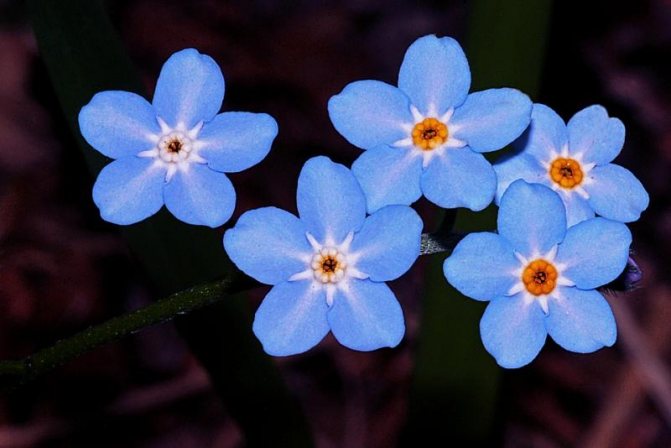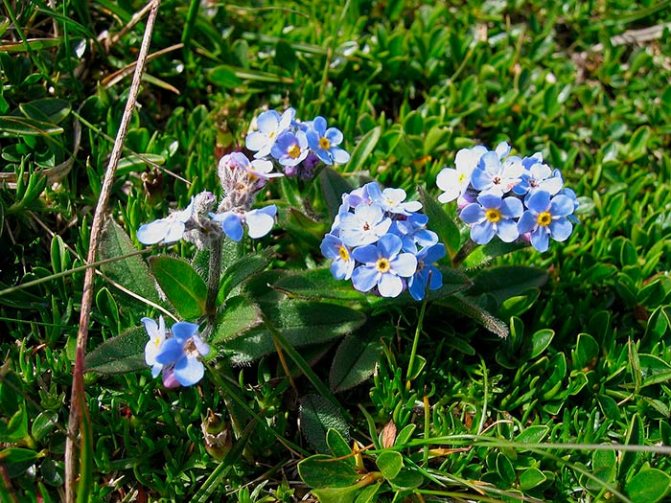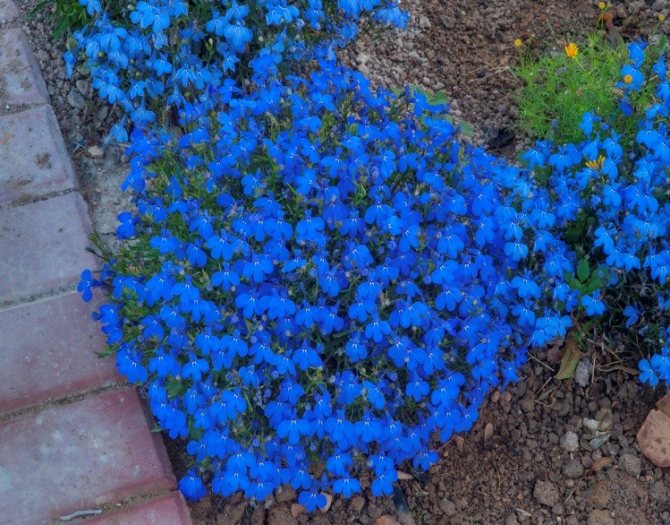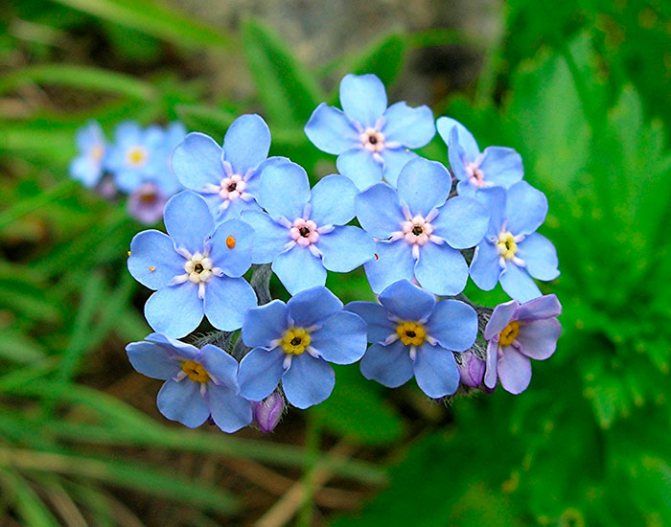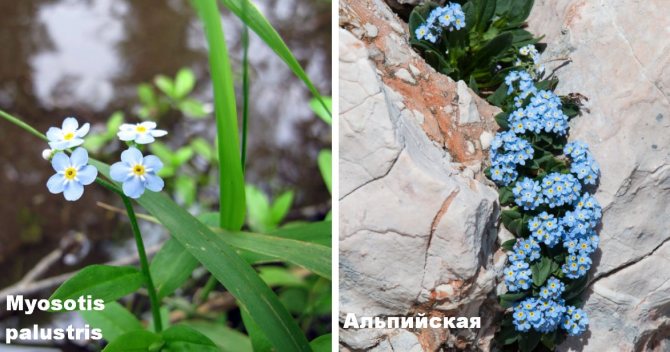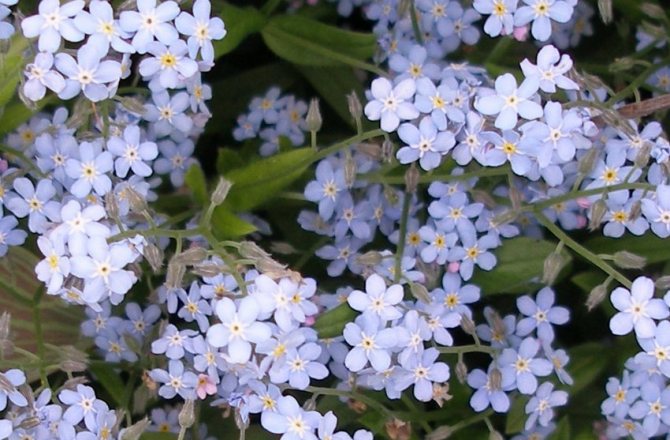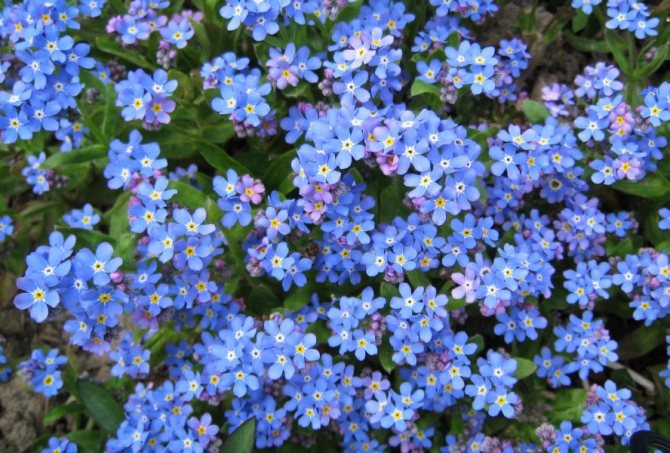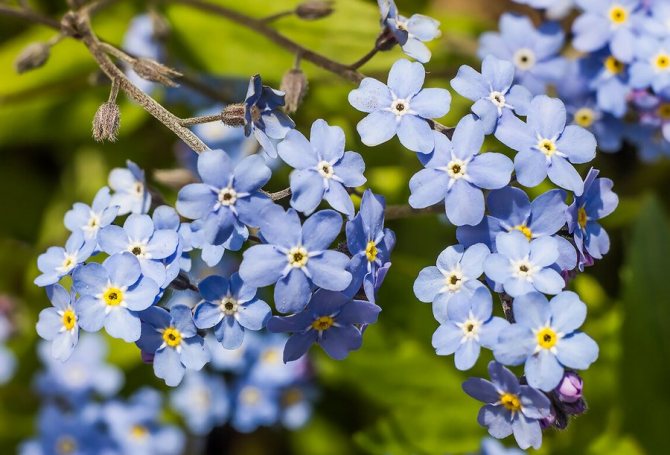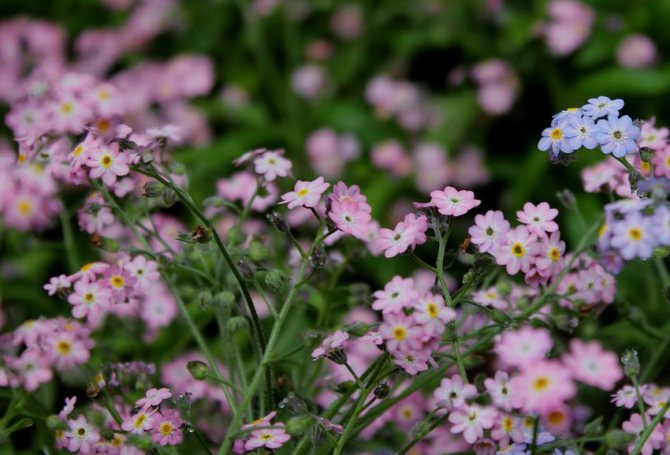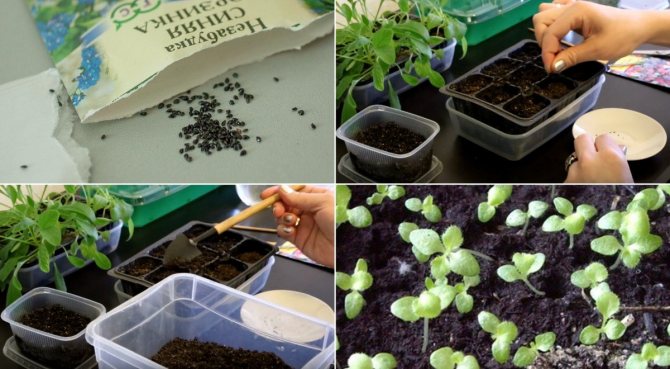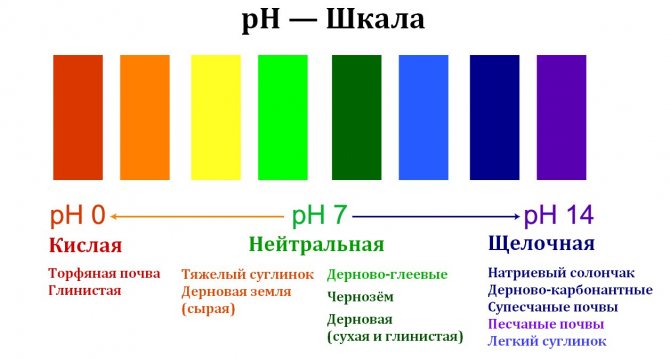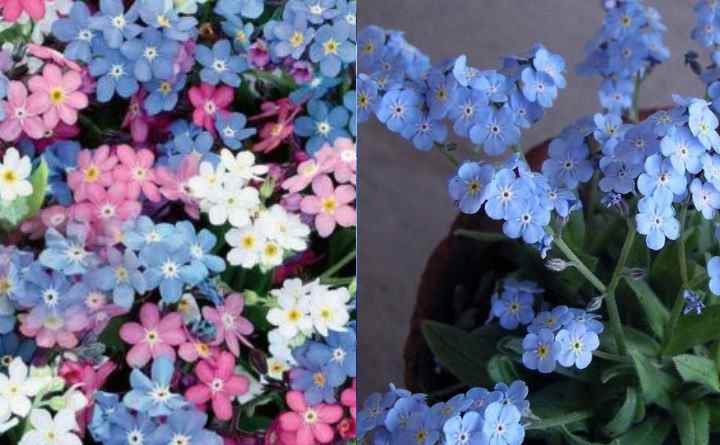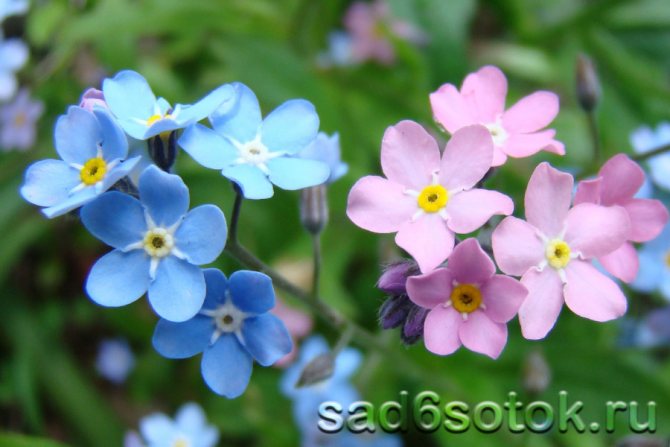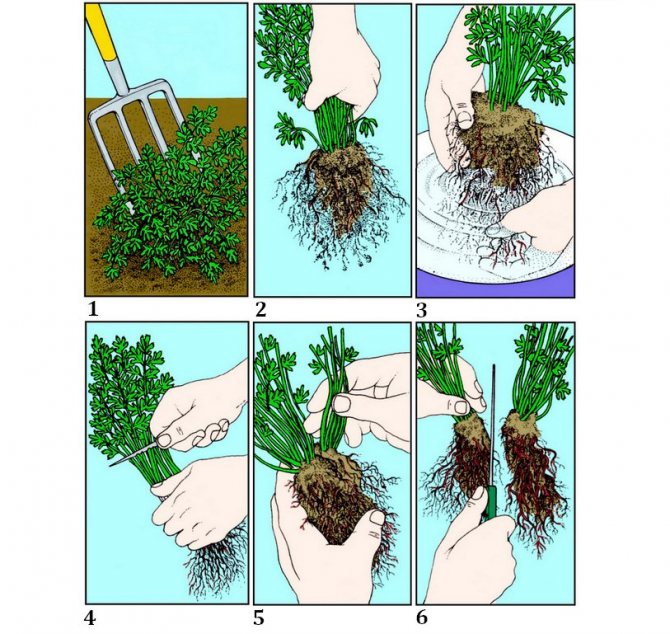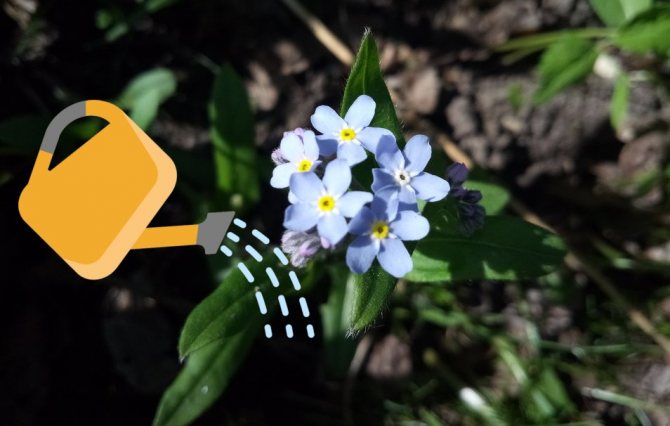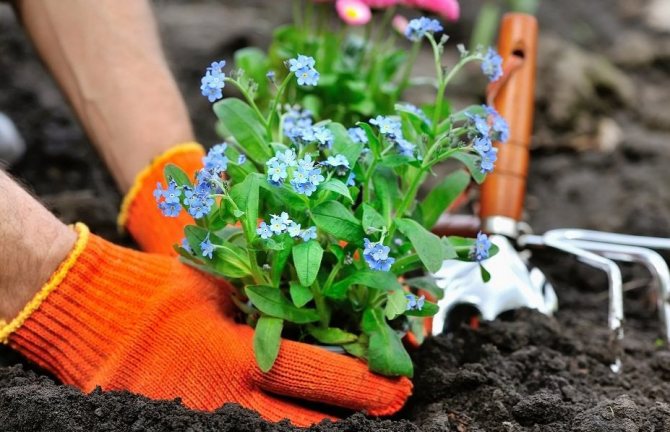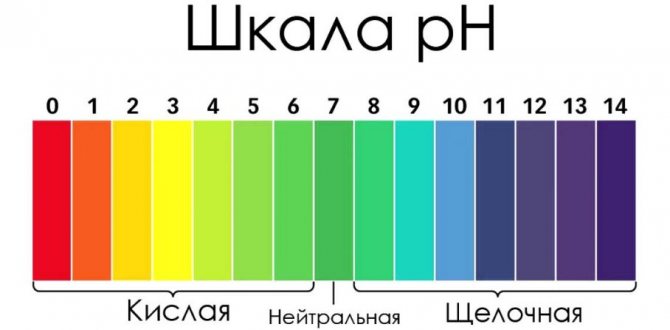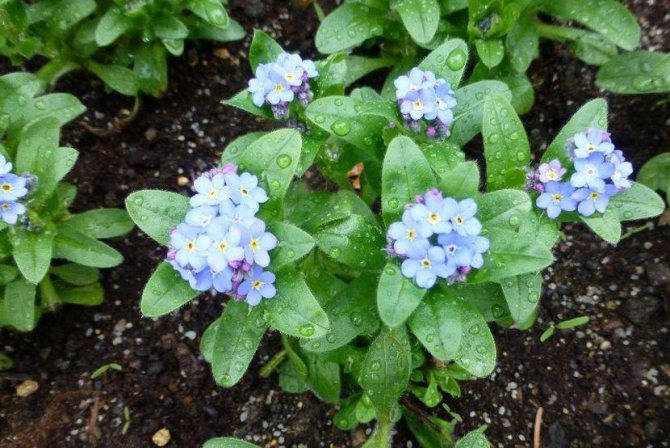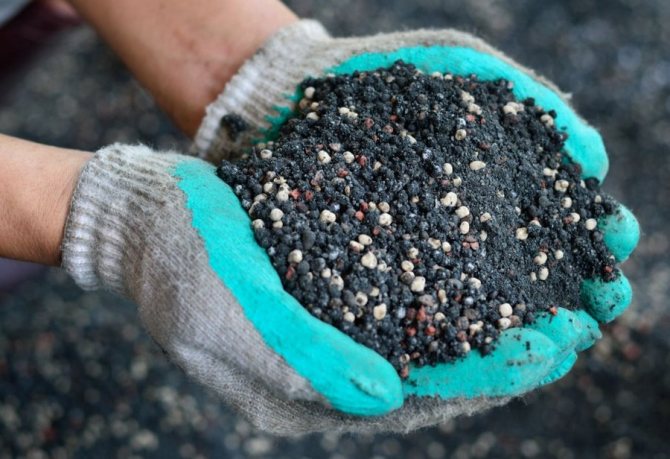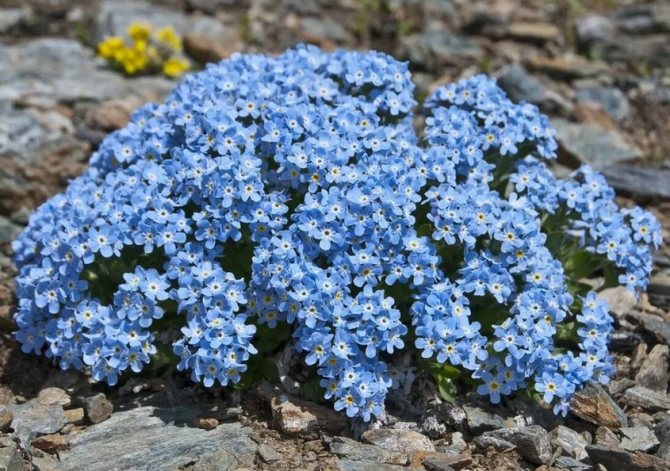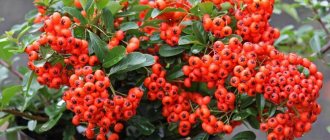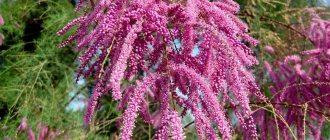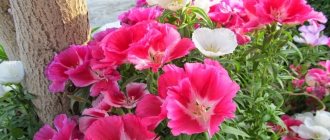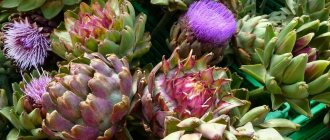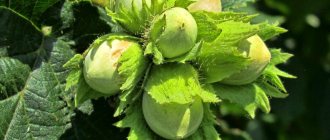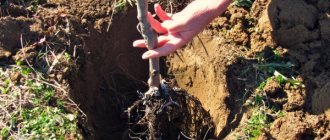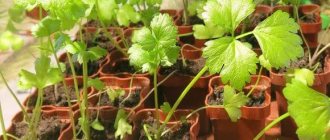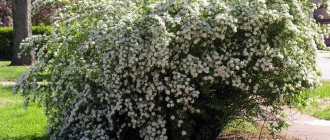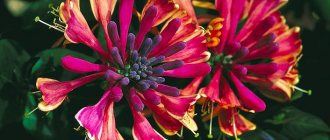Forget-me-not (Myosotis) belongs to the genus of herbaceous flora, included in the family Borage (Boraginaceae). The native area of distribution falls on European, American territories, they also cover the lands of Asia, the southern regions of the African continent, Australia and the islands of New Zealand. The genus itself has almost fifty varieties, of which 35 can be found in the countries of the former USSR. Forget-me-nots prefer to settle on well-moistened fresh soil, some of them grow in coastal areas next to water bodies, swampy areas or along large and small waterways.
| Family name | Borage |
| Growing period | Long-term, one- or two-year |
| Vegetation form | Herbaceous |
| Breeding method | Seed and only rarely vegetative (cuttings) |
| Landing period in open ground | April or August |
| Landing rules | The distance between seedlings is at least 10 cm |
| Priming | Moist, light to medium nutritious |
| Soil acidity values, pH | 6.5-7 (neutral) |
| Lighting degree | Sunny location or shading |
| Humidity parameters | Watering is needed if the leaves have lost turgor |
| Special care rules | No special care required during cultivation |
| Height values | 0.1-0.4 m |
| Inflorescences or type of flowers | Inflorescence curls or brushes |
| Flower color | Blue, pink or whitish |
| Flowering period | May to mid-June |
| Decorative period | Spring Summer |
| Application in landscape design | Flower beds and mixborders, decorating grass lawns, landscaping borders and coastal areas near water bodies, for cutting |
| USDA zone | 3–9 |
The genus got its name by merging two words in Greek "myos" and "ous", which have the translation "mouse" and "ear", respectively. All due to the fact that the leaf plates of the plant are characterized by dense pubescence of shortened hairs, resembling small ears of small rodents. It is curious that in various languages, not only those related to European, the sound of the name "forget-me-not" is practically indistinguishable. So, for example, in Polish it sounds "nezapominajki" (Niezapominajki), and in Bulgarian "nezabravka" and the like. There are other names among the people, among them gourd and pristine, as well as feverish herb, because of its medicinal properties.
Among the types of forget-me-nots, there are those that grow for only one or two years, but there are also those that have a long-term growing period. Branching stems reach 10–40 cm in height. Sessile leaf plates unfold on them in sequential order, taking on lanceolate, linear-lanceolate or spatulate outlines. There are varieties with an oval shape or an elongated tip. The color of the foliage is a rich emerald, grassy or grayish-green hue.
When blooming, small flowers bloom, which have a blue color of petals with a yellow center. Occasionally, the petals are pinkish or whitish. The calyx of the flower has bell-shaped contours. It has five lobes, which are formed by more or less strong separation. Inside the flower there are 5 stamens and a single pistil. The size across the open flower is 2–5 mm. The petals are located in the corolla very close to each other.
The inflorescences collected from the buds have a curl or brush shape.For forget-me-nots, flowering begins in late spring and lasts until mid-June. At the same time, the flowering period is extended for 2-3 weeks, but when the weather is cool, it becomes a little longer. It is noteworthy that spring frosts cannot damage this delicate plant.
As soon as the flowers are pollinated, the fruit ripens, made up of two pairs of nuts. These nut-like parts of it are called erems. When the fruit is fully ripe, erem separation occurs. The seeds ripening in them are very small. It is estimated that 1 g contains about 1500-2000 seeds. Their color is black, the shape is ovoid. Seed germination is not lost for 2-3 years.
The plant is quite unpretentious, such bushes can be used to decorate any flower bed or mixborder. Not only in Russian gardens you can see flower beds with delicate blue flowers, but also in European lands (in England, Sweden, Germany and France) "mouse ear" is not uncommon.
Description of forget-me-not
Forget-me-nots are one-, two- and perennial plants. Branched stems 10-40 cm tall. Leaves are sessile, lanceolate, linear-lanceolate or spatulate. Forget-me-not flowers are usually blue with a yellow eye, sometimes pink or white, collected in an inflorescence - a curl. Blooms from May to mid-June. The fruit is a nut. In 1 g, there are 1500-2000 black, ovoid, shiny seeds, the germination of which lasts 2-3 years. When sown, they germinate in 2-3 weeks. They are very fond of forget-me-not in England, France, Germany, Sweden, where it often decorates spring flower beds. And in Russia it is difficult to find a garden where this delicate, touching flower does not grow.
Of the 50 species of this genus, 35 grow on the territory of the former USSR. Krylov's forest forget-me-not (Myosotis krylovii) is similar to the forget-me-not - also a perennial with more developed fruitless shoots, growing in Siberia and Central Asia, and a two-three-year Sakhalin forget-me-not (Myosotis sachalinensis), found in the Far East. Annual forget-me-nots grow only in the mountain forests of the Caucasus. This is a related forget-me-not (Myosotis propinqua) with a rather large corolla and lazistan (Myosotis lazica) with small blue corollas and short fluffy pedicels, as well as a pleasant perennial forget-me-not (Myosotis amoena) - a long-rooted plant with a large flat limb, a white corolla, its seeds have a small ... The rare-flowered forget-me-not (Myosotis sparsiflora) with small corollas and sparsely separated leafy clusters is a common species in disturbed habitats, sparse forests and glades with fresh soil in the European part of Russia, Siberia, the Caucasus and Central Asia.
Forget-me-not: photo of flowers, cultivation, varieties, application
Forget-me-nots are a genus of plants of the Burachnikov family, which are found almost everywhere in the world. Forget-me-nots grow small in size, have small flowers. The genus includes about 50 varieties of such plants. One of the most common types is a blue flower with a yellow center.
Forget-me-nots, depending on the species, can be either annual, biennial or perennial. As a rule, certain species with blue and blue inflorescences will delight with flowering for several years. What does a forget-me-not flower look like? See the photo below.
There are varieties with pink shades of flowers.
General view of the plant.
The most common types and varieties
Forget-me-not is a flower that is common in many countries of the world, including in the vastness of Russia. On our territory you can find wild and bog flowers forget-me-nots. These small bushes are unpretentious to grow, so they can often be seen in gardens and garden beds. The plant loves moist soil. Alpine and field forget-me-not feels great in the sun. It is worth remembering that certain species take root well in the shade of trees or shrubs.The varieties that were bred for growing in pots are practically indistinguishable from others.
Swamp forget-me-nots (Myosotis palustris)
Such flowers can be seen in the forests and swamps of Siberia, the Balkans, Transcaucasia, Mongolia and Europe. The main differences from other species are that the marsh varieties have a branched stem, large leaves and small inflorescences with pink or blue petals. As for the size of the swamp forget-me-not, it can reach a height of 30 centimeters. The length of the leaves is about 4-5 cm, blooms in spring or early summer, flowering lasts until the end of summer. The plant will be a great option for decorating a pond or borders.
Alpine species (Myosotis alpestris)
As a rule, it grows in mountainous areas. This species is best grown in well-lit meadows. The species is characterized by a small rhizome and stem (up to 15 cm). In addition, the relatively short flowering time (about 7 weeks) is a disadvantage of the flower. Alpine forget-me-not has a dark blue color with dark green leaves. This type will delight with its flowering 2 seasons. The maximum height is 45 cm, has small flowers, only 1 cm in diameter. Alpine forget-me-not begins to bloom in early May and then for 20-30 days. After the end of flowering, fruits are formed - small nuts, which are used as seeds for the next year.
Alpine varieties differ in flowering duration, height, shape and color. Some of the most beautiful varieties are: Victoria (may have white, blue or pink flowers), Bluebird, Bluebell - this variety has blue flowers with stems up to 15 cm.
Bluebell
Field forget-me-nots (Myosotis arvensis)
In addition to external qualities, field varieties have some medicinal properties. Such plants are widely used for medicinal purposes. It blooms for 2 years, while it is worth remembering that there are also annual varieties of this species. Flowering begins in May and ends, depending on the variety, most often at the end of June. The plant is harvested during flowering and after the formation of seed pods.
Forest forget-me-not (Myosotis sylvatica)
Found in the Carpathians and European countries, perennial. It grows up to 30 cm, has light blue petals and light green leaves. Mostly observed in forests, in small glades.
To date, breeders have managed to bring out many different varieties of forget-me-nots, they have excellent characteristics and are often used in landscape design to decorate ponds and reservoirs, and form flower beds.
On the territory of Russia, you can rarely find the Alpine variety; in our country, its domesticated varieties, listed above, are planted. In seed shops you can find forget-me-nots for every taste and color, some varieties can bloom in two colors.
Growing and planting
Growing from seed and planting in the ground is the same for all varieties. As for leaving, different types require certain conditions to perform such actions. Plants are grown outdoors, usually from seeds. To plant seeds in the ground, you must:
- prepare the soil (fluff the ground, fertilize with peat and / or humus);
- level the ground;
- make small furrows and place seeds in them;
- after the first leaves appear, the seedlings must be thinned out or planted. In this case, it is worth considering the distance between plants in 4-5 cm;
- in late summer, biennial varieties should be transplanted elsewhere.
You can use seedlings to help plants bloom earlier. In this case, buy soil or prepare it yourself. It is best to buy special soil for flower seedlings. Then the seeds are planted in boxes with soil and wait for the first shoots.Before the shoots appear, it is best to water the ground through a sheet of paper with warm water. When leaves appear on the seedlings, boxes with flowers are sent to a cold greenhouse until spring. At the end of April, the seedlings are sent to the open, prepared ground in the manner indicated above. Plants grown from seedlings begin to bloom as early as May.
Outdoor care
Despite the fact that forget-me-nots are light-loving flowers, a shaded area would be the best option for them. At the same time, you should monitor the soil moisture near the flower bed with the plant. If the soil is too dry, the flower may die. Flowering and its duration also depends on the area where the flower is planted. In a sunny area, the plant will bloom for only 3 weeks, while in a shaded area up to 2 months.
In most cases, the plants are grown for 2 years, after which they are sown again. In the third year, the stems of the plant are too elongated, and the diameter of the flowers becomes smaller.
For soil, moderately damp soil with a little fertilizer is ideal. If the soil is oversaturated with moisture, the plant will stretch out, the stem will become thinner, and the flowers will be smaller. Too dry soil will not work.
Watering should be carried out as the soil dries up, depending on the weather conditions, the forest clearing of forget-me-nots on your site should not be oversaturated with moisture. If the plant is grown in the sun, the volume of water for irrigation is increased. It is not necessary to water the flower bed in the spring.
Fertilizers are applied only 3 times:
- Before planting the plant in the ground.
- Before flowering, after germination.
- In the autumn.
It is better to use liquid mineral mixtures for flowers as a fertilizer. These can be purchased at any gardening store. In autumn and spring, the meadow is fertilized with peat and humus.
When to plant forget-me-nots?
Seedling growing method:
- Annual plant - sow in late February-early March.
- Biennial plant - sow in May-June. In late August and early September, seedlings are transplanted to a permanent place.
For forcing plants in winter, seeds are sown in late February and early March. Further, the terms are as follows:
- in July-August, the resulting seedlings are transplanted into pots,
- at the end of September, the pots are brought into cool rooms with temperatures up to 0 ° C,
- in February, they are brought into a warm apartment.
How to use in landscaping?
Forget-me-not will be a great option for decoration flower beds, flower garden or balcony... Many varieties of flower can be grown at home. When choosing a place for planting forget-me-nots, it is worth considering the type and variety of this plant, the marsh one will perfectly decorate an artificial pond, the garden one - a flower bed, the alpine one will look great among the stones.
Forget-me-not goes well with tulips, lilies of the valley, daffodils... Daisies and pansies will also look great in the flower bed next to her.
To replace the forget-me-not, when it comes to the selection of plants for shaded and moderately damp areas of the garden, you can:
- lungwort,
- small-bulbous, daffodils, crocuses,
- chiostophyllum.
Below are photos of flowers in a flower bed:
Folk legends
In our country, forget-me-nots have other names, for example, they call it a pristine, feverish herb, gourd. Different peoples have different legends associated with this flower, but they are all united the concept of fidelity and good memory... In Greece and German folklore, there is a legend about a shepherd named Likas, who gave his bride, saying goodbye to her, a bouquet of forget-me-nots.
They also remember the ancient legend of a couple in love who went for a walk along the river. At the edge of the steep bank, the girl noticed a delicate blue flower. The young man climbed down to tear him down, but could not resist and found himself in the river, which caught him with a strong current.All that he had time to shout, before the wave covered him is: "Do not forget me!". This is one of many legends about a lovely blue flower with a yellow eye, telling how it got its interesting name.
This flower is considered by many to be witchcraft. Since a woven wreath made of it and put on the neck or placed on the chest in the region of the heart of a loved one is able to bewitch and hold him stronger than chains. The roots of forget-me-not have the same power.
Legends and beliefs
In many European countries, in ancient times, forget-me-not was honored as a special plant and even celebrated in her honor. In Russia, this flower was also called a pristine, feverish and witching herb. Our ancestors believed that if you put a wreath of forget-me-nots on your beloved, then he will bewitch him stronger than any witchcraft.
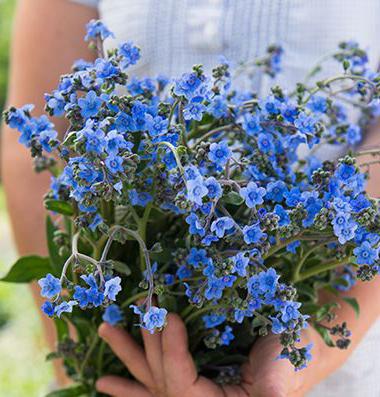
In Germany, there is still a widespread belief that the garden forget-me-not can open a treasure, and also help to find out the name of the betrothed. Blacksmiths in many countries believed that steel, hardened in the juice of this fragile plant, became stronger and lighter, and a blade from it could cut iron.
Types and varieties of forget-me-nots
Now many varieties of these wonderful flowers have been bred:
- Alpine forget-me-not - this species hardly grows in nature, but wonderful new varieties have been bred on its basis. It is a perennial plant with a dense rosette and a short rhizome. Bushes in the spring are completely covered with blue flowers. Reproduction takes place only with the help of seeds;
- Garden forget-me-not - on the basis of this species, varieties were bred: Victoria - with blue flowers and bushes, growing no more than 30 cm in height. Carmen King - fuchsia-colored flowers, plant height no more than 20 cm. Indigo - a plant with indigo flowers. All these varieties bloom in late spring.
- Swamp forget-me-not - a remarkably beautiful variety with blue flowers and a yellow center was bred on its basis. It is a perennial flower with large green leaves.
- Forest forget-me-not - this species has bushes with pink and blue flowers, flowering lasts a month and a half, the plant is perennial.
Forget-me-not marsh
In its natural environment, it grows in the Transcaucasia, the Balkans, Siberia, Mongolia and Central Europe. Blooms throughout the summer. Preferring moist soil, it is found on the shores of water bodies and swamps. Its characteristic features are branched stems, large leaves and flowers with pink or blue petals.
Alpine forget-me-not
Distributed in the Caucasus, Carpathians, Alps. Prefers a lot of light. It has a meek rhizome and a low stem 5-15 cm high. Its distinctive feature is gray-green leaves and dark blue petals. With its flowering, it will delight for about seven weeks.
Forget-me-not field
It is a medicinal plant. She has short shoots and small blue flowers. Her homeland is North Africa, Siberia, Asian countries, the Canary Islands.
Forget-me-not forest
It is a perennial plant. It can be found in the Carpathians and European countries. Its height is about 30 cm. It has pale green oval, elongated leaves and light blue flowers.
Currently, breeders have managed to bring out new hybrid types of flowers with multi-colored petals. There are flowers that have blue, blue, purple, cream, white and pink petals. Alpine forget-me-not is a rare guest in our gardens. Its domesticated counterpart is more common.
Garden views
Despite the great species diversity and many different modern varieties, the following forget-me-nots are most often used in floriculture and ornamental gardening:
- marsh (Myosotis palustris);
- forest (M. caespitosa);
- alpine (M. alpestris);
- parted-flowered (M. dissitiflora);
- alpine garden (M. x hybrida hort).
In gardens, a special cultural form is most often found - the Alpine garden forget-me-not.
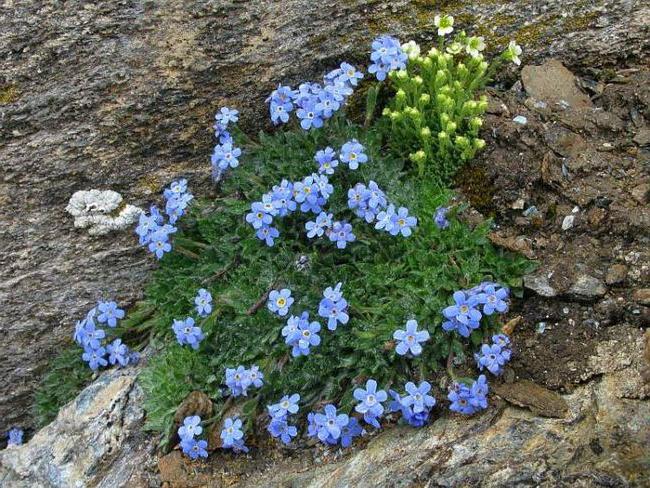

On the basis of it and the species listed above, various hybrids have been created today and many varieties have been bred, differing from each other not only in the color of the petals.
Outdoor care
Despite the fact that forget-me-nots are light-loving flowers, a shaded area would be the best option for them. At the same time, you should monitor the soil moisture near the flower bed with the plant. If the soil is too dry, the flower may die. Flowering and its duration also depends on the area where the flower is planted. In a sunny area, the plant will bloom for only 3 weeks, while in a shaded area up to 2 months. The note! Exceptions are field and alpine species and varieties. A common garden blue forget-me-not grows well with larger, taller flowers that provide shade for it. In most cases, the plants are grown for 2 years, after which they are sown again. In the third year, the stems of the plant are too elongated, and the diameter of the flowers becomes smaller. For soil, moderately damp soil with a little fertilizer is ideal.
If the soil is oversaturated with moisture, the plant will stretch out, the stem will become thinner, and the flowers will be smaller. Too dry soil will not work. Watering should be carried out as the soil dries up, depending on the weather conditions, the forest clearing of forget-me-nots on your site should not be oversaturated with moisture. If the plant is grown in the sun, the volume of water for irrigation is increased. It is not necessary to water the flower bed in the spring. Fertilizers are applied only 3 times: Before planting the plant in the ground. Before flowering, after germination. In the autumn. It is better to use liquid mineral mixtures for flowers as a fertilizer. These can be purchased at any gardening store. In autumn and spring, the meadow is fertilized with peat and humus.
Note! Forget-me-nots love fresh soil, so it must be loosened periodically. As for weeding, it must be carried out as soon as weeds appear on the plantation. When to plant forget-me-nots? Seedling method of growing: Annual plant - sow in late February-early March. Biennial Plant - Sow May-June. In late August and early September, seedlings are transplanted to a permanent place. For forcing plants in winter, seeds are sown in late February and early March. Further, the terms are as follows: in July-August, the obtained seedlings are transplanted into pots, at the end of September the pots are brought into cool rooms with temperatures up to 0 ° C, in February they are brought into a warm apartment. How to use in landscaping? Forget-me-not will be an excellent option for decorating a flower bed, flower garden or balcony.
Many varieties of flower can be grown at home. When choosing a place for planting forget-me-nots, it is worth considering the type and variety of this plant, the marsh one will perfectly decorate an artificial pond, the garden one - a flower bed, the alpine one will look great among the stones. Forget-me-not goes well with tulips, lilies of the valley, daffodils. Daisies and pansies will also look great in the flower bed next to her. You can replace forget-me-not when it comes to the selection of plants for shaded and moderately humid areas of the garden: lungwort, small-bulbous, daffodils, crocuses, chiostophyllum.
Location and lighting
Flowers will grow well both in the shade and in the sun. But in a shaded place, they will bloom longer, acquiring a more saturated shade.
The soil
For forget-me-nots, moderately moist meadow soil is suitable. Too nutritious soil is not suitable for them, since the plant will grow vigorously and bloom poorly. Poor sandy soils are also not suitable for the plant. If you plant a forget-me-not in an overly wet area, it will hurt and stretch out a lot in length. Therefore, the ideal conditions for growing these beautiful flowers are in moderately humid areas of land with a small amount of fertilization.
Watering rules
If the forget-me-not grows in the shade, watering the plant should be moderate. In late spring, it is not necessary to water the flowers, since the soil contains the required amount of moisture. When forget-me-nots grow in sunny areas, watering is increased so that its leaves always remain fresh and elastic.
Fertilizers and feeding
It is not worth feeding the plant too often. Fertilizers are applied to the soil three times. Young forget-me-nots must be fed two weeks after planting, before flowering. For this, liquid mineral fertilizers are used. Organic and mineral fertilizers must also be applied in the fall. And in the spring, a small amount of peat and humus is introduced into the soil. Since forget-me-nots are more fond of fresh soil, it is regularly loosened so that the plant receives all the necessary nutrients. Flowers do not need additional shelter for the winter.
Forget-me-not flowers practically do not require weeding, as they have a powerful fibrous system that does not allow weeds to break through.
We create conditions
After the plant has been planted in a permanent place, it needs to be provided with moderate regular watering and fertilizing with mineral fertilizers. When watering, you should try not to get water on the plant itself, but direct the stream closer to the roots.
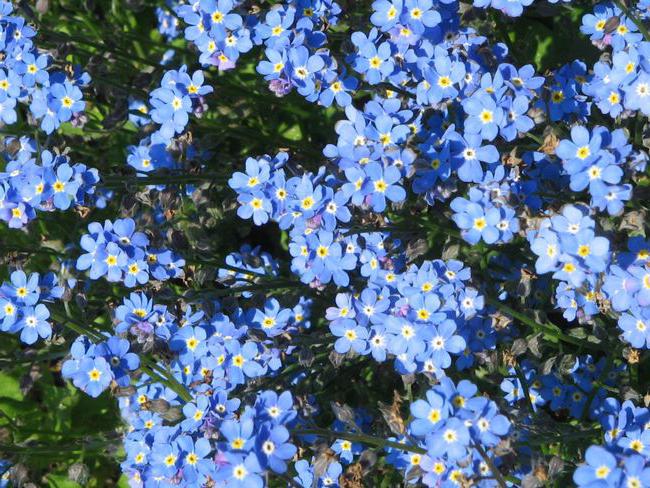

The first feeding is carried out before flowering, about 14 days after planting the plant in a permanent place. Complex mineral fertilizers dissolved in water according to the instructions are suitable for this purpose. In the fall, both organic and mineral fertilizers are applied to the soil under forget-me-nots, and in the spring a small, about 5 cm, layer of peat-mixture or well-rotted compost mixed with garden soil is poured under the bushes. It is important to remember that garden forget-me-not is quite aggressive and spreads quickly by self-seeding. To prevent this, you should immediately remove the faded twigs, thereby preventing the setting of seeds and their further unauthorized "movement" in your area.
Diseases and pests
Forget-me-nots can be affected by gray mold and powdery mildew. In the first case, the bushes are saved by cutting off diseased plant elements, the rest by processing with Bordeaux liquid or copper sulfate. Powdery mildew can be handled by spraying in the morning or evening with a solution containing the following components: 10 liters of water, 1 kg of wood ash and laundry soap. Gardeners advise, as a precautionary measure, to systematically remove weeds on the site, make a low planting and water the plants sparingly.
Forget-me-not in landscape design
The plant is widely used in various types of compositions on personal plots, terraces, balconies.
Perfect for the design of reservoirs of any size, alpine slides, border plantings. It goes well with tulips, daffodils, lilies of the valley, snowdrops, white flowers, daisies, ferns, hosts.
You can buy forget-me-not as part of bouquets. The cut plant can retain its decorative appearance for up to 2 weeks.
Forget-me-not will add tenderness to any personal plot. Numerous varieties with different flower colors allow you to choose an instance for every taste. The plant does not require complex care, which even more attracts the attention of gardeners to it.
Forget-me-not beneficial properties
Forget-me-not petals contain anthocyanins, due to which the petals turn blue. These substances largely determine the medicinal properties of the plant - it eliminates inflammation, helps to remove phlegm from the lungs and reduce sweating, and stops the blood. Basically, in medical practice, juice and powder are used in the treatment of cancerous tumors of the oral cavity and organs of the reproductive system, less often - a decoction from the roots externally for eye diseases and as an additive for baths for skin rashes and dry eczema.
A discreet flower with petals of heavenly blue - forget-me-not in Latin is called Myosotis, which means "mouse ear".
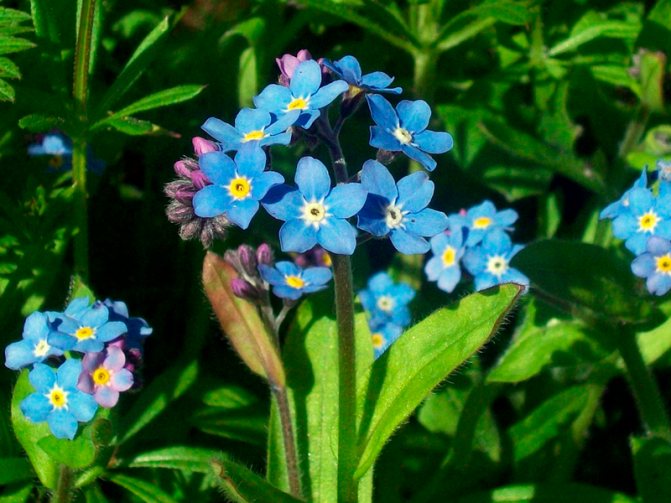

Many legends and folk beliefs are associated with it in most countries of the world. They are united by a common meaning - since ancient times, the plant has been considered a symbol of fidelity, good memory.
Description and features of the plant
Forget-me-not is a genus of annual and perennial plants belonging to the Burachnikov family. The natural habitat of the flower is quite extensive. It can be found in abundance in regions of Asia and Europe, characterized by high humidity, and in southern Africa, North and South America, Australia, New Zealand and Russia.
Common features:
The plant is mainly ornamental. Adult bushes grow no higher than 35cm in the taller varieties.
The stem is covered with delicate green foliage and light fluff to its full height.
Depending on the variety, the leaves may differ slightly in shape.
The flower petals are mostly blue, pink and white.
The size of the inflorescences is not large, but they literally dot the bushes with themselves.
Alpine forget-me-not and other species
The people also often call the flower "prigozhitsa", "grolianka". It looks discreet: bushes from 10 to 40 cm tall with highly branched stems and many sessile leaves are crowned with small inflorescences-shields. Flowers of garden varieties are small (but much larger than wild ones), usually 5-7 mm in diameter, blue, pink or white with a bright, like the sun, yellow core.
Flowering begins in the first third of summer and ends in July. Uncultivated species continue to open buds until cold weather.
A representative of the Burachnikov family is grown as one-, two- or perennial. But by the end of the third season, the stems of the plant are excessively stretched, the number of flowers decreases. Planting rejuvenates, removing old, sowing a new generation.
Popular varieties
Garden forget-me-nots with flowers painted in various shades of pink are popular today:
- Victoria Rose.
- Rosilv.
- Carmen King.
- Pink dawn.
- Hope.
Blue and blue garden forget-me-nots are always in demand, the cultivation of which is exactly the same as that of flowers of a different color.
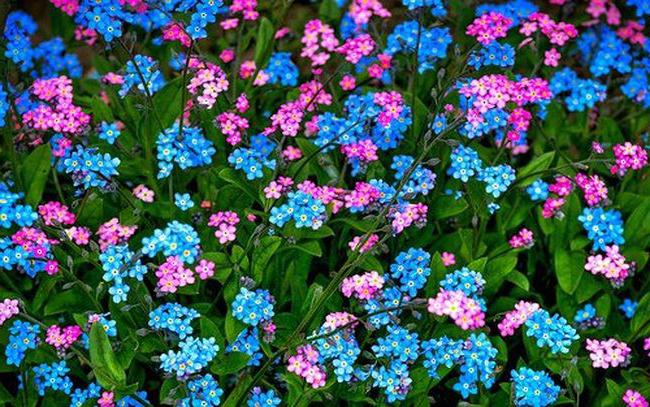

Such dark blue varieties as Blue King, Indigo, Blue Basket, Ultramarine are quite widespread. Lovers of sky blue and light blue will be pleased with such varieties of garden forget-me-nots as Music, Golubye Dali, Compinidi, Miro, Victoria, Pompadour.
Planting forget-me-nots
Most beauties prefer slightly shaded areas, some prefer full shade. The exception is field and alpine varieties, which bloom actively only in well-lit areas.
Flowers do not make serious demands on the soil: moderately fertile soil with good aeration, stagnation of water is undesirable. Forget-me-not is planted in the garden in one of two ways, directly by seeds in a flower bed or seedlings.
Spring sowing of seeds in open ground
When the soil warms up well, it is loosened, peat or humus is added. After 2-3 weeks, they are dug up again, leveled.
For sowing, small holes are prepared at a distance of 10 cm from each other. The sown seeds are covered with a thin layer of earth, covered with polyethylene on top. Seedlings appear in 2 weeks. Seedlings are thinned out to provide them with comfortable growing conditions.
Autumn sowing for seedlings
It is carried out at the very beginning of winter. The seedling boxes are filled with a substrate of a third of the washed river sand and two-thirds of the disinfected sod land. Seeds are scattered over the surface of the soil, slightly pressed, lightly sprinkled with earth.
Then the crops are moistened through a spray bottle. The first shoots appear by the end of the first week. When the first 2-3 true leaves are formed, the seedlings are transplanted into separate cups and placed in an unheated greenhouse until spring. When the snow melts, the cups with seedlings are transferred to a moderately warm room. Seedlings are planted on flower beds in April. By this time, buds are already forming on most plants.
Forget-me-not: reproduction, combination with other plants
Seeds are the most popular breeding material for forget-me-nots. Test them by dipping them in salted water before planting.Floated samples are not ready for planting. The plant grows efficiently and self-sowing, so it is not necessary to do annual sowing in the flower bed. The main thing is to have time to plant young plants.
Other options for breeding culture:
- Cuttings. In early summer, cut green cuttings 4-5 cm from the tops. Root them in the greenhouse, then plant them in the open field. As a result, the plant will bloom in the first season, but weakly and for a short period.
- Division of the plant. Such reproduction can be carried out at any time of the year. The root system of the plant is strong and well developed.
Alpine forget-me-not is simply created for rockeries, ground cover compositions. Combination options can be seen in the photo. The combination of different shades of forget-me-not looks beautiful. Whole carpet compositions can be created from them. Forget-me-not brings a meadow spirit to the landscape. Use this property to decorate your site.
Conditions for growing forget-me-nots
Grolianka is distinguished by its unpretentiousness, it does not require special conditions. A sufficient amount of light and shade, moderate watering, rare top dressing, measures to protect against pests and diseases do not take much time and are available to novice growers.
Watering
Irrigation is required 2 times a week for flowers growing in open sunny areas, alpine slides. Inhabitants of shady corners are watered once a week, provided there is no natural rainfall.
To reduce hassle, forget-me-nots are usually planted in the company of garden plants that reliably shade the soil.
Top dressing
On excessively fertile soil, the pristine begins to fatten - to increase only the leaf mass. Therefore, fertilizers must be handled with extreme caution. During the season, it is enough to add peat or humus twice - in spring and autumn, and immediately after flowering water with liquid mineral complexes.
Other care activities
Experienced flower growers recommend regularly, at least once every 10-15 days, to loosen the soil so that nutrients and oxygen can freely flow to the roots.
Flowers do not need weeding - a powerful root system drowns out weeds trying to get out of the ground.
There is no need to prepare flowers for winter. The roots perfectly tolerate severe frosts even without a snow cover. Sometimes summer residents simply mulch plantings with a thin layer of dry leaves.
Forget-me-not care rules
Garden forget-me-nots do not require as much care as many other more whimsical flowers. There are only a few things to do, but it's important to do them regularly:
- Water.
- Loosen the top layer of soil and weed out weeds.
- Sometimes fertilize.
- Clean the rows and combat thickening of the plantings.
Top dressing and watering
Frequent feeding is not required. A little complex mineral fertilizers are enough half a month after planting in open ground. And add some humus and peat next spring.
Water should be plentifully, but carefully. Do not allow the earth to dry out, but also do not allow water to stagnate in the plantings. The game is to keep the soil slightly moist. Therefore, the frequency of watering is highly dependent on weather conditions and is done on an occasion.
Post-flowering care
The post-flowering stage and immediately after the appearance of the first spring shoots are the two main phases in which you can do the main work of caring for the propagation of shoots:
At the end of the flowering period, more than half of the bushes can be safely dug up and removed - the remaining amount is enough for self-seeding.
In the spring, when the sprouts begin to sprout and grow stronger, you can also control how densely they have sprouted and, if necessary, transplant some shoots.
If you do not skip both of these phases, then your beds will always look fresh and well-groomed.But, if you skip one or two phases, then a pleasant flower can imperceptibly turn into an overgrown weed.
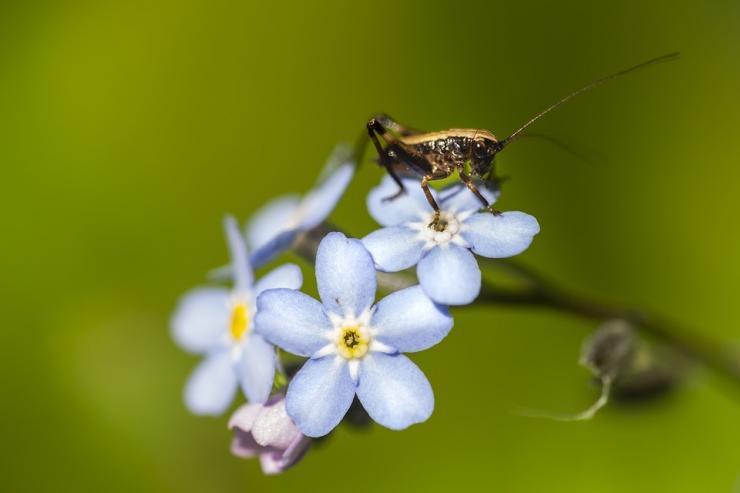

Wintering
All that can be said about wintering is that forget-me-not flowers are resistant to cold weather and do not need special shelters for wintering.
Reproduction of forget-me-not
All traditional methods are suitable for reproduction: using seeds, cuttings, dividing the bush.
Seeds
Harvested as it ripens. After drying, they are poured into a tissue bag and stored until sowing, but not more than 3 years. You can immediately sow fresh seeds in flower beds and flower beds. However, it should be remembered that hybrid forms of forget-me-nots do not convey varietal characteristics if they are propagated in this way.


Sometimes summer residents do not even bother collecting seeds - the pristine grows well by self-sowing. In the spring, young bushes are carefully dug up and planted in the right place.
Dividing the bush
The best way to increase the number of hybrid forms. The procedure can be carried out at any warm season, the hardy root system tolerates division without damage and easily takes root in a new place.
The bushes are dug up, carefully divided into several parts. Each piece is planted in a prepared hole.
Cuttings
Also used for propagation of hybrid and varietal highly decorative forget-me-nots. At the end of flowering, the apical shoots are cut with a sharp disinfected knife. They are planted immediately, covered with polyethylene or glass transparent containers. Watering is carried out very carefully: water on the leaves is extremely harmful to cuttings. In order for the bushes to branch, they are pinched 1-2 cm.
With this method of reproduction, grolianids bloom in the same year. But for the winter they need to be covered with spruce branches or agrofibre.
Forget-me-not pests and diseases
Flowers are highly resistant to disease. Excess watering can be the only cause of damage.
Waterlogged soil is a favorable environment for the development of fungal infections - powdery mildew, root rot, gray rot. If signs of the disease appear on the leaves and stems, they are treated with any fungicide (copper sulfate, HOM, Skor, Fitosporin and others).
To prevent an outbreak of infection, the planting density is monitored, the plants are thinned in a timely manner. Drying out of the soil or prolonged stagnation of moisture under the flowers is also avoided.
Pests also do not actively attack forget-me-nots, which greatly facilitates caring for them. Insecticides are used only when parasites are found or in the event of their massive invasion of the area.
Forget-me-nots - planting and leaving
Forget-me-not from the Burachnikov family is often called the queen of May. Glades of a heavenly hue appear in late spring on forest edges and meadows, but these are wild species.
Many flower growers are already accustomed to the fact that their site is invariably decorated with a variety of decorative forget-me-nots, planting and caring for them always pays off handsomely.
A pretty plant will enrich the flowering range with spectacular gentle strokes. It is not for nothing that in many languages the essence of the name of a modest beauty is preserved - “do not forget me”. There are at least 50 hybrid species, and they are used in floriculture. There are, of course, many more varieties.
The flowers can be blue, light blue, pink, purple, cream, white, and even with a tiny yellow center. The height of the plants also differs, for example, the Alpine forget-me-not rarely reaches 20 centimeters, and the garden one easily reaches 35 cm. It usually blooms from May to the end of June.
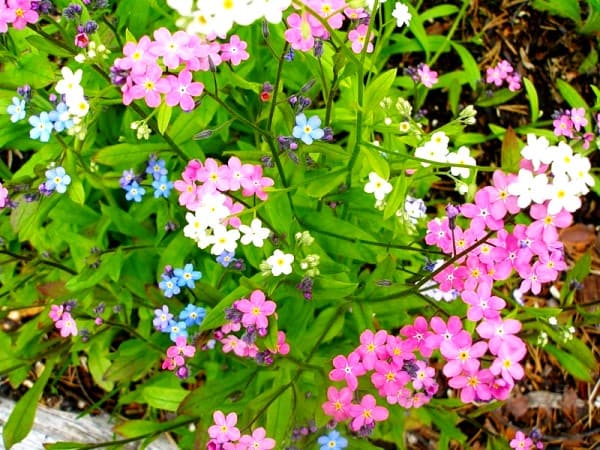

Forget-me-not garden
All varieties are distinguished by genetic plasticity, i.e. when grown from seeds, retain their properties. However, most flower growers are already convinced that even a perennial forget-me-not will not please for more than two years. The inflorescences will become scarce, the stems will become excessively elongated.
Mister Summer resident informs: forget-me-not is a healer of the respiratory tract
In addition to unpretentious decorativeness, the pristine is appreciated for its medicinal properties, known for a long time.Traditional medicine uses the plant as a hemostatic, anti-inflammatory and expectorant. Treatments for bronchitis, some forms of tuberculosis and pulmonary lesions are effectively complemented by the humble flower.
Raw materials for the preparation of medicinal compositions are prepared during flowering. Use the entire aerial part - stems, leaves, inflorescences. Drying is carried out in the shade in a ventilated room or under a canopy, where there is no draft. Then the raw material is crushed, stored for up to a year in glass, ceramic or paper bags.
When harvesting forget-me-not flowers for medicinal purposes, take into account that varietal and hybrid forms are not suitable for these purposes.
The best raw materials are considered to be field and forest species, ideally wild ones. Some folk recipes using forget-me-not herb:
- With bronchitis, residual cough, fevers, 3 tablespoons of dried raw materials are poured with a glass of boiling water. Insist for an hour, then filter. Drink a tablespoon three times a day after meals.
- Tea brewed with the addition of forget-me-not (1: 1) helps with asthma, upset stomach or intestines, kidney disease.
- A decoction of two teaspoons of dried herbs in a glass of water helps with impotence.
- Fresh juice of leaves and stems is used as an adjuvant in the treatment of malignant lesions of the oral cavity.
- Green parts chopped into gruel are an excellent hemostatic and wound healing agent. The mass is applied to open wounds, burns, frostbitten areas.
Scientists have not identified contraindications to the use of medicinal decoctions and forget-me-not infusions. But pregnant or lactating women, as well as people with allergies, should first consult a doctor.
Some housewives use delicate flowers for culinary purposes. For example, they sugar and decorate ceremonial pastries - cakes or pastries. Or frozen in water to decorate cocktails.
«>
Forget-me-not flower
A discreet flower with petals of heavenly blue - forget-me-not in Latin is called Myosotis, which means "mouse ear".
Many legends and folk beliefs are associated with it in most countries of the world. They are united by a common meaning - since ancient times, the plant has been considered a symbol of fidelity, good memory.
Alpine forget-me-not and other species
The people also often call the flower "prigozhitsa", "grolianka". It looks discreet: bushes from 10 to 40 cm tall with highly branched stems and many sessile leaves are crowned with small inflorescences-shields. Flowers of garden varieties are small (but much larger than wild ones), usually 5-7 mm in diameter, blue, pink or white with a bright, like the sun, yellow core.
Flowering begins in the first third of summer and ends in July. Uncultivated species continue to open buds until cold weather.
A representative of the Burachnikov family is grown as one-, two- or perennial. But by the end of the third season, the stems of the plant are excessively stretched, the number of flowers decreases. Planting rejuvenates, removing old, sowing a new generation.


Scientists count more than 50 species of forget-me-nots that grow in all corners of the Earth, where there is a lot of moisture, sometimes in swamps. The most common among florists are:
- Alpine, inhabiting the middle mountains of the Caucasus, in the Carpathians, the Alps, in the Altai, in the south of the Urals. The height of the plant is about 15 cm, its petals are of a rich dark blue color, the leaves are light green. In bright light, the flowering period is about 2 months. In the gardens of the flat part of Russia, a specially bred garden variety is grown. Tall dark blue Music, 15-centimeter Indigos, dwarf pink Rosilva, soft blue lush babies Victoria are popular with gardeners.
- Swamp, grows wild along the edges of swamps and ponds. The species is distinguished by large flowers - up to 12 mm in diameter, very long stems. The corolla is blue or pink.Thuringen is prized for its deep blue, almost blue flowers.
- Field, growing in almost all open places where the soil retains moisture for a long time. Stems are of medium height, petals are small, blue in color.
- Forest, lover of shady thickets. A tall plant that blooms profusely with pink, blue or blue flowers. Popular varieties are Miro, Roggli, the Magnum series.
- Parted-flowered, originally from Switzerland. Large corollas bloom profusely on 30-centimeter spreading stems. The variety Blau Grasmuk is widespread among domestic florists.
In the gardens there are also cultivated forms of fragrant forget-me-not, Sakhalin, Lazistan, pleasant and some other species.
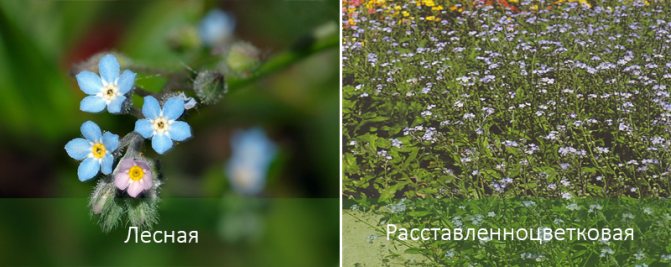

Hybrid varieties are the results of the work of breeders. The color of the petals, depending on the variety, ranges from delicate to deep blue.
Planting forget-me-nots
Most beauties prefer slightly shaded areas, some prefer full shade. The exception is field and alpine varieties, which bloom actively only in well-lit areas.
Flowers do not make serious demands on the soil: moderately fertile soil with good aeration, stagnation of water is undesirable. Forget-me-not is planted in the garden in one of two ways, directly by seeds in a flower bed or seedlings.
Spring sowing of seeds in open ground
When the soil warms up well, it is loosened, peat or humus is added. After 2-3 weeks, they are dug up again, leveled.
For sowing, small holes are prepared at a distance of 10 cm from each other. The sown seeds are covered with a thin layer of earth, covered with polyethylene on top. Seedlings appear in 2 weeks. Seedlings are thinned out to provide them with comfortable growing conditions.
Autumn sowing for seedlings
It is carried out at the very beginning of winter. The seedling boxes are filled with a substrate of a third of the washed river sand and two-thirds of the disinfected sod land. Seeds are scattered over the surface of the soil, slightly pressed, lightly sprinkled with earth.
Then the crops are moistened through a spray bottle. The first shoots appear by the end of the first week. When the first 2-3 true leaves are formed, the seedlings are transplanted into separate cups and placed in an unheated greenhouse until spring. When the snow melts, the cups with seedlings are transferred to a moderately warm room. Seedlings are planted on flower beds in April. By this time, buds are already forming on most plants.
Conditions for growing forget-me-nots
Grolianka is distinguished by its unpretentiousness, it does not require special conditions. A sufficient amount of light and shade, moderate watering, rare top dressing, measures to protect against pests and diseases do not take much time and are available to novice growers.
Watering
Irrigation is required 2 times a week for flowers growing in open sunny areas, alpine slides. Inhabitants of shady corners are watered once a week, provided there is no natural rainfall.
To reduce hassle, forget-me-nots are usually planted in the company of garden plants that reliably shade the soil.
Top dressing
On excessively fertile soil, the pristine begins to fatten - to increase only the leaf mass. Therefore, fertilizers must be handled with extreme caution. During the season, it is enough to add peat or humus twice - in spring and autumn, and immediately after flowering water with liquid mineral complexes.
Other care activities
Experienced flower growers recommend regularly, at least once every 10-15 days, to loosen the soil so that nutrients and oxygen can freely flow to the roots.
Flowers do not need weeding - a powerful root system drowns out the weeds trying to get out of the ground.
There is no need to prepare flowers for winter. The roots perfectly tolerate severe frosts even without a snow cover. Sometimes summer residents simply mulch plantings with a thin layer of dry leaves.
Reproduction of forget-me-not
All traditional methods are suitable for reproduction: using seeds, cuttings, dividing the bush.
Seeds
Harvested as it ripens. After drying, they are poured into a tissue bag and stored until sowing, but not more than 3 years. You can immediately sow fresh seeds in flower beds and flower beds. However, it should be remembered that hybrid forms of forget-me-nots do not convey varietal characteristics if propagated in this way.
Sometimes summer residents do not even bother collecting seeds - the pristine grows well by self-sowing. In the spring, young bushes are carefully dug up and planted in the right place.
Dividing the bush
The best way to increase the number of hybrid forms. The procedure can be carried out in any warm season, the hardy root system tolerates division without damage and easily takes root in a new place.
The bushes are dug up, carefully divided into several parts. Each piece is planted in a prepared hole.
Cuttings
Also used for propagation of hybrid and varietal highly decorative forget-me-nots. At the end of flowering, the apical shoots are cut with a sharp disinfected knife. They are planted immediately, covered with polyethylene or glass transparent containers. Watering is carried out very carefully: water on the leaves is extremely harmful to cuttings. In order for the bushes to branch, they are pinched 1-2 cm.
With this method of reproduction, grolianids bloom in the same year. But for the winter they need to be covered with spruce branches or agrofibre.
Forget-me-not pests and diseases
Flowers are highly resistant to disease. Excess watering can be the only cause of damage.
Waterlogged soil is a favorable environment for the development of fungal infections - powdery mildew, root rot, gray rot. If signs of the disease appear on the leaves and stems, they are treated with any fungicide (copper sulfate, HOM, Skor, Fitosporin and others).
To prevent an outbreak of infection, the planting density is monitored, the plants are thinned in a timely manner. They also avoid drying out the soil or prolonged stagnation of moisture under the flowers.
Pests also do not actively attack forget-me-nots, which greatly facilitates caring for them. Insecticides are used only when parasites are detected or in the event of their massive invasion of the area.
Mister Summer resident informs: forget-me-not is a healer of the respiratory tract
In addition to unpretentious decorativeness, the pristine is appreciated for its medicinal properties, known for a long time. Traditional medicine uses the plant as a hemostatic, anti-inflammatory and expectorant agent. Treatments for bronchitis, some forms of tuberculosis and pulmonary lesions are effectively complemented by the humble flower.
Raw materials for the preparation of medicinal compositions are prepared during flowering. Use the entire aerial part - stems, leaves, inflorescences. Drying is carried out in the shade in a ventilated room or under a canopy, where there is no draft. Then the raw materials are crushed, stored for up to a year in glass, ceramic or paper bags.
When harvesting forget-me-not flowers for medicinal purposes, take into account that varietal and hybrid forms are not suitable for these purposes.
The best raw materials are considered to be field and forest species, ideally wild ones. Some folk recipes using forget-me-not herb:
- With bronchitis, residual cough, fevers, 3 tablespoons of dried raw materials are poured with a glass of boiling water. Insist for an hour, then filter. Drink a tablespoon three times a day after meals.
- Tea brewed with the addition of forget-me-not (1: 1) helps with asthma, upset stomach or intestines, kidney disease.
- A decoction of two teaspoons of dried herbs in a glass of water helps with impotence.
- Fresh juice of leaves and stems is used as an adjuvant in the treatment of malignant lesions of the oral cavity.
- Green parts chopped into gruel are an excellent hemostatic and wound healing agent. The mass is applied to open wounds, burns, frostbitten areas.
Scientists have not identified contraindications to the use of medicinal decoctions and forget-me-not infusions. But pregnant or lactating women, as well as people with allergies, should first consult a doctor.
Some housewives use delicate flowers for culinary purposes. For example, they sugar and decorate ceremonial pastries - cakes or pastries. Or frozen in water to decorate cocktails.

